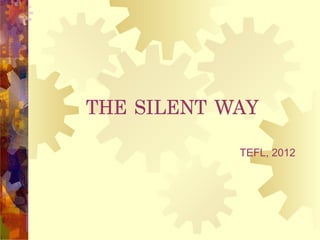
Silent way method
- 1. THE SILENT WAY TEFL, 2012
- 2. Theoretical background 1. Challenge audio-lingual method: Ss are unable to transfer habits formed in the classroom to communicate outside of it. 2. Noam Chomsky: Language must not be considered a product of habit formation, but rule formation.
- 3. Language acquisition must be a procedure of people using their own thinking process, or cognition, to discover the rules of the language they are acquiring.
- 4. 3. Cognitive approach Rather than responding to stimuli, Ss are: responsible for their learning engaged in formulating hypotheses to discover the rules of target language (grammar)
- 5. Background American educator, Galeb Gattegno created in the 70s, 1983. Basic principle: Teaching should be subordinated to learning. Teaching is to serve learning process rather than to dominate it. Learners are actively searching for rules of the target language regarding to the learner in the cognitive approach.
- 6. Learning is a process which we initiate by ourselves by mobilizing our inner resources. (perception, awareness, cognition, imagination, intuition, creativity..) In the process of learning, we integrate into ourselves whatever ‘new’ that we create, and use it as a stepping stone for further learning.
- 7. Teaching-learning process Gattegno “The teacher works with the students; the students work on the language”. In a period of class, teacher should not talk more than 10%. Have Ss talk.
- 8. Students should use language for self- expression. Students develop their inner criteria for correctness.
- 9. Only the learners can do the learning. Ss is to make use of what they know. Learning is Ss’ personal responsibility. Teacher should respect the autonomy of the learners in language. Teaching involves only one structure at a time.
- 10. With minimal spoken cues, Ss are guided to produce the structure. Ss practice without repetition. Ss gain autonomy in the language by exploring it. T sets up situation to ‘force awareness’ through the use of nonverbal gestures and the tools which are available.
- 11. Principles Teachers’ goals: Ss use the language for self-expression through their thoughts, perceptions and feelings. They need to develop independence from the teacher. Develop their own criteria for correctness. The teacher should give them only what they need to promote their learning.
- 12. Teacher/students’ role Teacher’s role he/she is a technician or engineer. The teacher relies one what his students already know. Focus on students’ perceptions, force their awareness, and provide exercises to insure their facility with the language.
- 13. Students’ role Ss make use of what they know. Free themselves of any obstacles that would interfere by paying attention to the learning task. Actively engage in exploring the language.
- 14. Characteristics TL process Students begin their study through its basic building blocks and its sounds. Teacher sets up situations that focus on student attention to the structures of the language. Students receive a great deal of practice with a given target language structure without repitition.
- 15. Students-teacher interaction The teacher is silent. He is still very active in setting up situations to force awareness, listen attentively to students’ speech and silently work with them on their production. Give the clues, not to model the language.
- 16. Student-student interaction They learn from one another the teacher’s silence is one way to do this
- 17. Area of language Since sounds are the basic, pronunciation is worked on from the beginning. Focus on the structures of the language but explicit grammar rules may never be supplied. Start for what students know and build from one another to the next.
- 18. All skills are worked from the beginning of the course.
- 19. Role of native language Meaning is made clearly by focusing on students’ perceptions, not translation. Native language can be used to give instructions when necessary. Native can exploited to introduce the new sounds in TL.
- 20. evaluation Never give a formal test, he assesses student learning all the time. Teaching is subordinated to learning teacher must be responsive to immediate learning needs. Teacher doesn’t praise or criticize student behavior because it would interfere students’ development. Teacher looks for steady progress, not perfection.
- 21. Students’ errors Errors are seen as a natural, essential part of the learning process. Errors are inevitable since the students are encouraged to explore the language. (teacher) errors are used as a basis for deciding where further work is necessary.
- 22. The teacher works with students in getting them to self-correct. If students/peers are unable to correct, teacher would supply the correct language.
- 23. Techniques Self-correction gestures Sound-color chart Teacher’s silence Word chart Peer correction Fidel chart Rods Structured feedback
